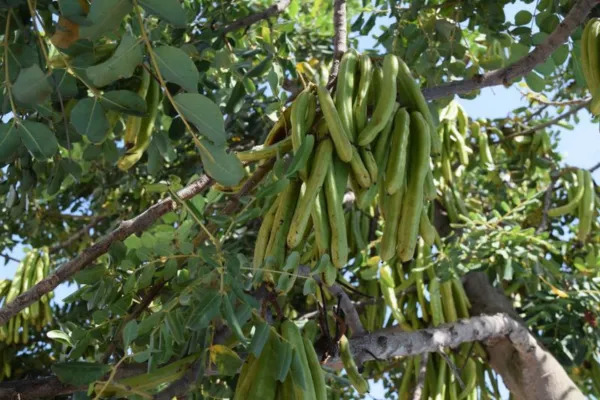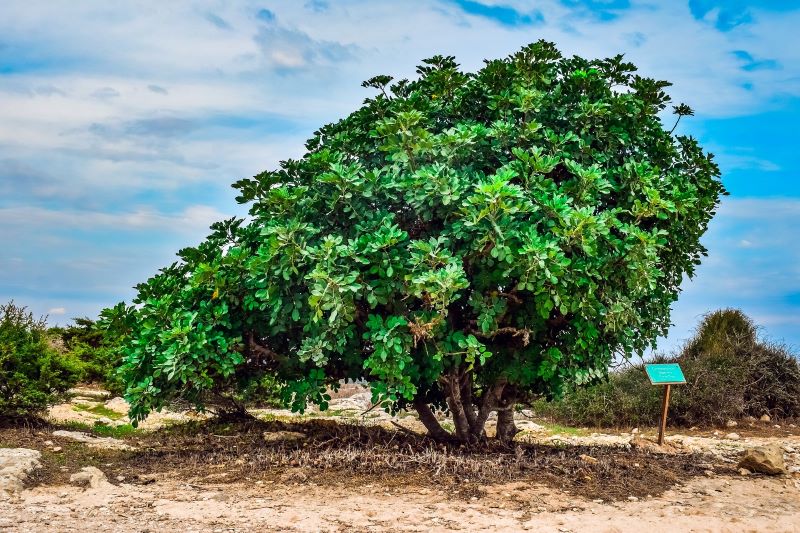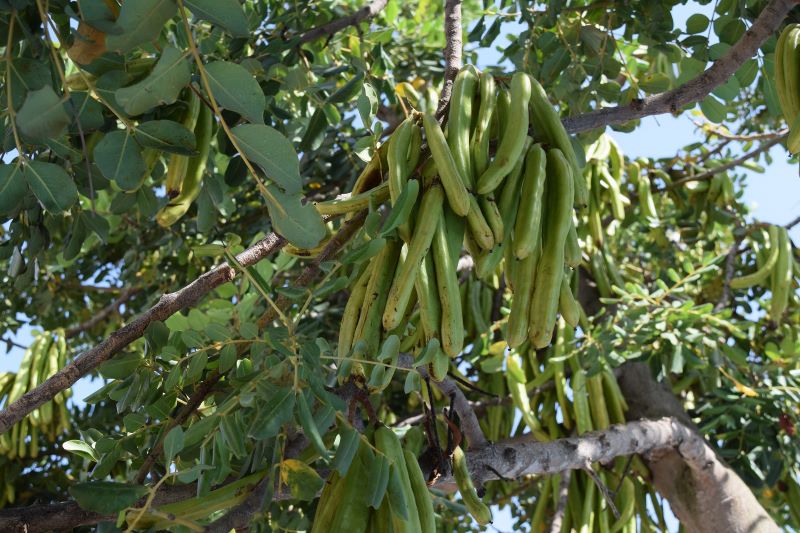
Your Backyard Fruit Bowl – Carob
Carob pods: Image by Hans via pixabay.com
This month we continue the theme of “What could we grow here, if we really needed to?” in a time of soaring food costs and increasing global instability. Unfortunately, New Zealand is highly unlikely to become a cocoa-production hotspot, so I have turned my focus to a cocoa substitute – love it or hate it, carob. The darling of the 1970s wholefood movement, where carob and all its derivatives masqueraded as a healthy alternative to the “harmful stimulant” that was cocoa. Still much-maligned, the preserve of health-food shops and basically a dirty word at kids’ parties when I was growing up in the ‘80s, carob is a bit more acceptable these days. I’ve come to appreciate it not as a chocolate substitute, but as a flavour and food additive in its own right.
Most of us know carob as a brown, powdery substance similar to cocoa in taste and texture. The tree itself is a pod-bearing legume, and it is the outer pod structure itself, not the seeds inside, that is ground to produce the familiar powder. The pods can be chewed on as a snack, or pieces purchased in bite-size form sold as ‘kibble’.
If you’re familiar with raw carob products, one of the major differences that sets it aside from cocoa is its remarkable natural sweetness – the sugar content of the pods can be as high as 50-72%. Carob also contains useful amounts of protein and dietary fibre, along with B vitamins and a host of minerals. Also on the plus side, it doesn’t contain caffeine or theobromine, the alkaloid in cocoa that makes chocolate products so toxic for dogs, so is used widely to manufacture mock-chocolate treats for our canine friends.
Carob (Ceratonia siliqua) has its origins in the Middle East and the Mediterranean and modern production centres on the latter, with Portugal, Italy and Morocco the top producers. It is also cropped commercially with good success in Australia. So, what do we know of it in New Zealand? The New Zealand Tree Crops Association has records of carob trees growing from Kaitaia in the north to Otago in the south, and trees producing pods as far south as the Nelson region.
Ready to grow more fruit at home? Explore our full series on backyard orchards for tips and how-tos
Carob: a short family history
Belonging to the legume family (the Fabaceae or Leguminosae), its relatives include other well-known edibles such as peas, beans and peanuts, flavoursome culinary staples including licorice and tamarind, and the rather exotic inga or ‘ice cream’ bean. More specifically, it belongs to the subfamily Caesalpinioideae, a group of trees and woody shrubs with tough, leathery pods. Senna, with its well-known laxative properties also sits within this group – interesting to note that carob is known for having the exact opposite effect on the innards! The fearsome ornamental-turned-feral honey locust also belongs here, which has been widely planted as an ornamental but has a tendency to be quite an invasive species outside its native range.
Carob also goes by the monikers St John’s bread and locust bean. It’s quite probable that the term locust was originally given to the carob tree (and several other tree relatives also bear some form of the name) and assigned to the desert-dwelling, famine-causing Orthopteran insect sometime later. It has long been considered a famine food for both animals and humans, and the Biblical connection establishes that carob pods were most likely the ‘locusts’ that St John the Baptist survived on during his time in the desert.
If the name locust bean gum sounds familiar, that’s because the tooth-shattering seeds inside the carob pods yield a gum that’s useful for paper and textile manufacturing and a host of commercial food manufacturing applications, including as a stabiliser and thickener in meat and dairy products, fruit fillings for pies, and other bakery products. It is also utilised in the production of cosmetics and pharmaceuticals.
Suitable climates and growing conditions

Carob-tree: Image by Dimitris Vetsikasa via pixabay.com
Carobs can be grown in warm-temperate and subtropical regions and naturally, have a strong affinity for Mediterranean-type climates: cool winters with moderate rainfall, mild spring temperatures and fairly hot summers with low rainfall.
Carobs are hardy and drought-tolerant, and also cope well in maritime environments, so are an acceptable choice for coastal areas affected by salt spray. For this reason, they also make a good windbreak species, providing protection for other plants. They are grown widely in Hawaii, Arizona and California as an amenity species, and in the latter state, quite commonly along highway median strips due to their tolerance of air pollution, with the added bonus of their springy branches absorbing the impact energy from car accidents rather well.
Carobs are said to be about as cold hardy as an orange tree, so if your climate permits orange production, carobs could be worth a try. In New Zealand, trees have been exposed to frosts down to -8°C, which was noted to damage young foliage but no permanent damage was sustained to the main tree itself. Carobs are interesting in that they flower in late autumn to early winter and the fruit sets during winter, so prolonged frosts during this period are likely to negatively impact fruit production.
Carobs don’t require winter chilling to set fruit, they are long-lived and can remain productive for 80-100 years. The trees are quite slow-growing in the juvenile stage, particularly in the first year, and growth is somewhat slower in general in the cooler southern regions of New Zealand. Trees are reasonably large at maturity – heights of 13-15 metres and spreads of up to 10 metres are common. If planting commercially, Australian growers recommend planting carobs at a spacing of 9-10 metres on the square.
Carob trees are largely dioecious (male and female flowers borne on separate trees), so more than one tree is required to set fruit. The sex of seedling trees can’t be determined until they flower at about four years of age – purchasing grafted trees of known gender is one way around this. There are some hermaphroditic varieties available, which are self-fertile and produce well, and can be included in orchard blocks to assist with pollination. Grafting male branches onto female trees is another way round the problem of pollination.
Carob flowers are insect-pollinated and borne on wood three years of age and older, and a large proportion of the fruit and flowers arise directly from older limbs and branches rather than new growth. This is known as cauliflory and is also exhibited in other fruit crops including jaboticaba, figs, cocoa and jackfruit. The flower racemes are small, dark red-burgundy in colour and have a pungent scent designed to attract said pollinating insects. Female flowers are distinguished by the tiny pod they carry, whilst the males are composed of stamens and anthers.
The fruit are 10-30 cm long, about an inch wide and shaped like the standard flattened leguminous pod, light to dark brown and glossy when mature (the carob’s botanical name translates roughly as ‘horny long pod’). Translucent pale brown pulp encases 10-15 hard brown seeds – the ancient Greeks and Romans actually used these to provide a standardised weight for jewellery, giving rise to the carat (sound familiar?).
Grafted trees crop around the six years of age mark, with a yield of around two kilograms of pods. Production climbs to around 45 kg at 12 years of age and upwards of 90 kg at age 25-30 years.
Propagation from hard, dry seed is relatively easy, but germination rates are low. Seed is available for purchase from Kings Seeds and other outlets online. You will need to soak the seed in water and/or chip the seed coat (scarification) prior to planting. Choose deep pots such as rootrainers to grow your seedling on in, as carob seedlings have very long taproots that don’t like being disturbed. If you can locate fresh carob seed, this gives far better strike rates.
Smaller specialist nurseries stock carob plants and may ship them around the country, if grafted plants of known gender are available, even better. If you have a good supply of pencil-thick carob seedlings and a good scionwood source of ideally two-year old wood, you can graft your own using the whip and tongue method, timed to coincide with strong growth between early November to March. Use two-bud sections of scionwood, seal the top cut with pruning paint, enclose each graft in a plastic bag and keep in a heated greenhouse at around 40°C for best results.
Site selection and planting
Choose a sunny, sheltered position for your carobs. Some protection from wind is desirable, especially for commercial plantings. Given that the trees grow very slowly in the first few years, you want to give them the best start possible.
Carobs are tolerant of a wide range of soil types, as long as they are well-drained. Avoid heavy or strongly acidic soils. Planting holes need to be deep and well-dug to accommodate the long taproot – because of this, choose your planting site carefully with this in mind, as they do not transplant well if you need to move them later. You can add a little well-rotted compost or manure to planting holes, but make sure it is covered with a layer of native soil before the plant goes in, to prevent burning the roots.
The deep taproot, strong lateral root system and ability to grow in poor soils and coastal conditions makes carobs a great soil-stabiliser for areas at risk of erosion.
Culture and care

Carob flowers: Image by Eve Gluecka via pixabay.com
Carobs are the ultimate do-gooders in terms of water and nutrients. They are very drought-tolerant once established, and will thrive where conditions allow for around 500 mm of annual rainfall. Young plants may need some extra water during the summer months, particularly in drier regions.
Deep-rooted carobs have the ability to access nutrients from the depths of the soil profile and aren’t gross feeders, so supplementary fertiliser isn’t necessary.
Pruning
Carobs are grown as freestanding trees and naturally have thick trunks and broad canopies which grow relatively close to the ground. Remove the standard crossing, diseased and damaged branches to open up the canopy and allow light and air to penetrate. Choose the removal of newer wood over older, as fruit is produced on three-year-old plus wood.
Pests, diseases and what to do about them
Trunk and root rots may be an issue in wetter climates, as may fungal diseases in humid climates. Scale insects may be present, but cause only very minor damage.
What to do with your crop

Green carob pods: Image by JoostGa via pixabay.com
Once harvested, carob pods need to be dried before storage as damp pods will quickly ferment due to their high sugar content! They can be dried in the sun, or by artificial means (on the home scale, a dehydrator or very low oven) until the moisture content drops to around 8%. The pods are then crushed and the hard seeds removed.
The flavour of carob is enhanced by roasting the pods before use. This can be done in a low oven, set to 125°C. Spread the pods in a single layer on a baking tray and roast for 10-15 minutes. Don’t walk away and overdo this, due the high sugar content, mere seconds lie between full bodied flavour and charcoal.
Cool the pods and crack to remove the seeds. They can then be roughly broken up and ground in a spice grinder until a powder of the desired consistency is reached.
Store the prepared powder in airtight containers.
Seedless carob kibble or meal can be fed to livestock, and is said to have a similar nutritional value to barley. Because of its high tannin content, it is usually only fed in small quantities. Of note is carob’s usefulness as a treatment for lamb scours if the small woolly beasts have overindulged on lush spring grass. Anecdotally, it also has the same effect on small children with upset tummies – carob powder given in a glass of milk can help settle digestive upsets.
Useful as an autumn-winter bee fodder species, carob honey is said to be somewhat of a delicacy, with buttery, chocolatey and earthy aromatics and a slightly bitter aftertaste.
Carob in its various forms is made into a wide variety of drinks, syrups and sweets across many cultures. I picked up a bottle of carob molasses (in a similar bent to pomegranate molasses) from a Middle Eastern grocery earlier in the year and it makes a great less-sweet dessert topping, with a rich carob flavour and a slight hint of bitterness. I’ve learned in Lebanon it is mixed 3:1 with tahini and used as a spread on bread – note to self to try that.
In Cyprus, carob pods are soaked in water, the resultant liquid strained and then reduced to produce a syrup called haroupomelo. When boiled down even further, it produces a toffee-like sweet called pasteli.
I’ll leave you with a simple recipe for a handy instant drink mix that combines the best qualities of carob and chocolate, the perfect introduction to carob for the uninitiated. It’s great to take tramping as you can just add water if that’s all you have. It has great flavour, ample natural sweetness and no strange additives, making it rival anything you’ll find on the supermarket shelf.
In a large glass jar with a screw-top lid, combine 100 g carob powder, 100 g cocoa powder and 100 g milk powder of your choice (oat milk powder works well for a non-dairy option). Shake well to combine; you might need to sieve everything together first if any of your powders have lumps. If you have a sweet tooth, you can add some vanilla sugar to taste (readily available in the Dutch foods section at Bin Inn or larger supermarkets). Add 1-3 teaspoons to a mug and top up with boiling water and/or milk to taste.
Disclaimer: the information supplied above is of a general nature and provided as reference material only. In regards to pest and disease control, please consult your agrichemical consultant for suitable products, application rates and further region-specific information.
Anna-Marie Barnes is an active member of the New Zealand Tree Crops Association who endeavours to grow and preserve as much of her own fresh produce as possible. When the weather’s no good for gardening, she can usually be found inside working on a batch of homemade cheese or soap.
The New Zealand Tree Crops Association is a voluntary organisation promoting interest in useful trees, such as those producing fruit, nuts, timber, fuel, wood, stock fodder, bee forage and other productive crops. Find out more about the NZTCA here: https://treecrops.org.nz/
Image Credits:
Carob flowers: Image by Eve Gluecka via pixabay.com
Carob pods: Image by Hans via pixabay.com
Carob-tree: Image by Dimitris Vetsikasa via pixabay.com
Green carob pods: Image by JoostGa via pixabay.com

